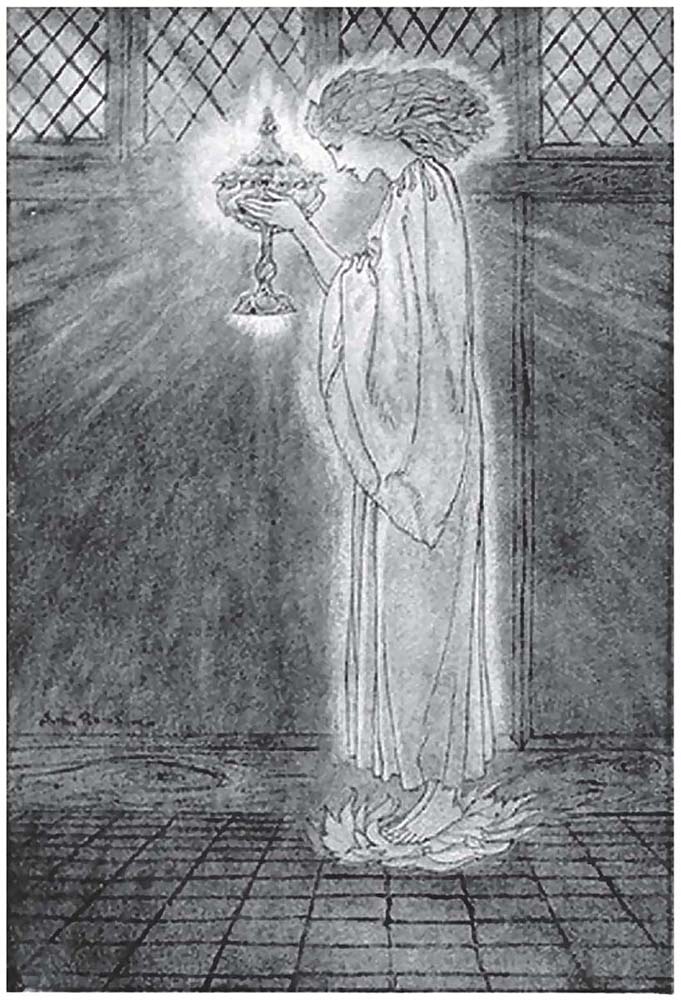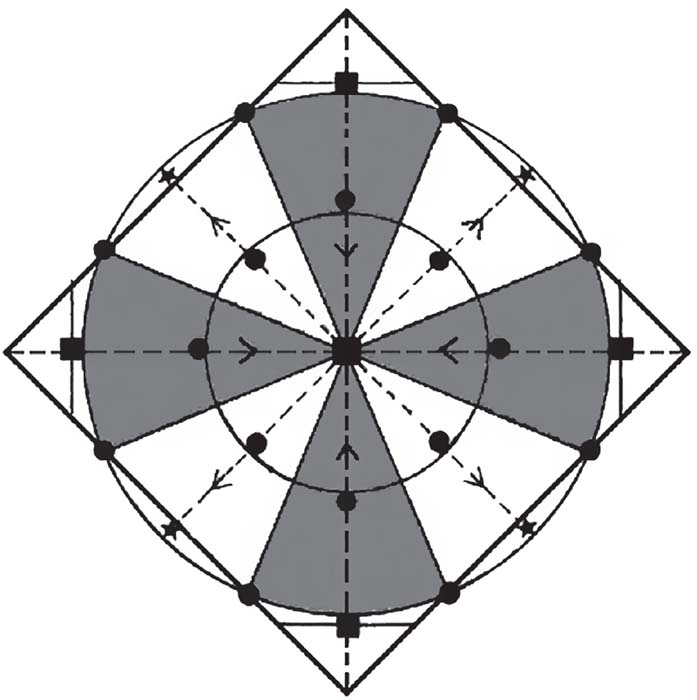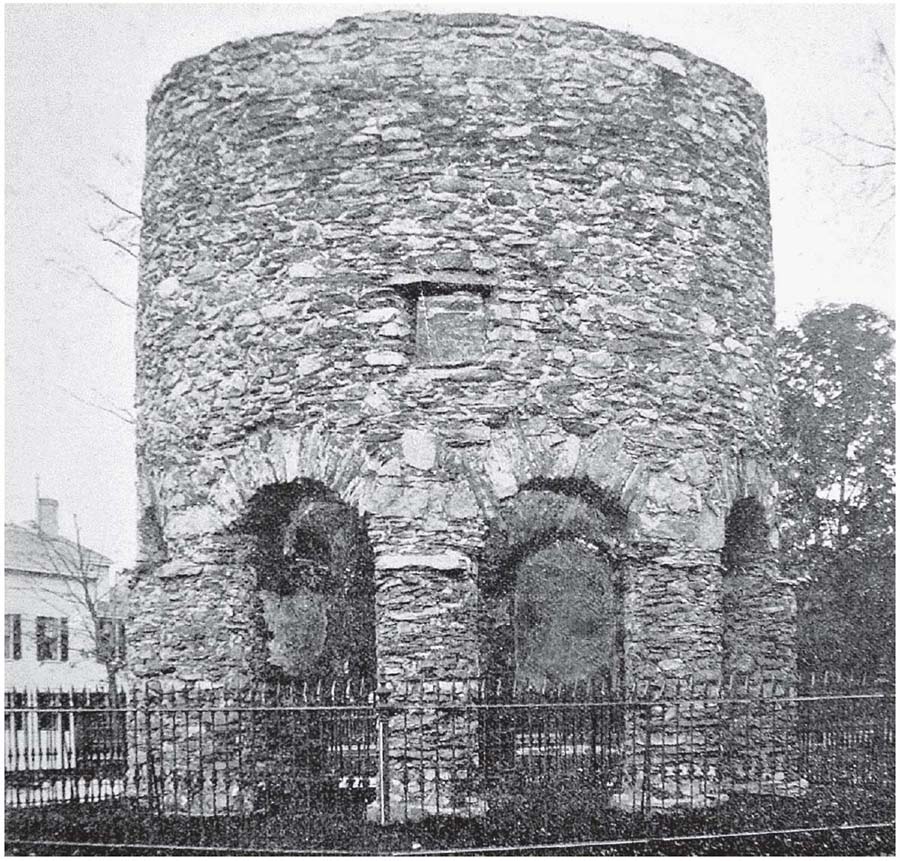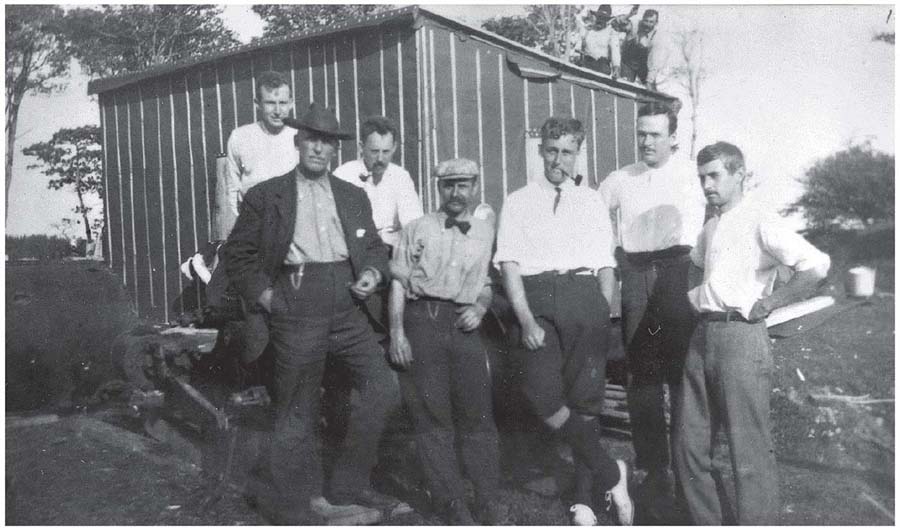10
INTO THE SHADOWS
The information in the previous chapters points to treasures hidden over the years by people associated with the Freemasons, Rosicrucians, and possibly the Knights Templar. Those who buried these treasures employed codes involving Kabbalah, gematria, alchemy, astronomy, Greek mythology, cartography, and art. The idea that these people would place treasure across an entire continent using such an elaborate map, which would have taken decades if not longer to lay out, and that they would bury such a large amount of treasure, is bewildering. Yet that is exactly what they did. We started with my mother, Betty Dorsett Duke, and a treasure map written by her great-grandfather, Jesse James. Living a peaceful, law-abiding life in Texas under the alias of James Lafayette Courtney, he was a Freemason. We read how he and other Freemasons, including George Roming, buried a large treasure in central Texas. From there we traveled back in time, through a line of Freemasons linking the Founding Fathers of the United States to the Bruton Parish Church and the College of William and Mary. These in turn are linked to Freemasons, the Royal Society, Rosicrucians, and Francis Bacon. We went even further, past Francis Bacon, John Dee, and Nicolas Poussin, through Christopher Columbus and some of history’s most famous Christian Kabbalists, philosophers, and artists, as well as Jewish rabbis, all the way back to the Knights Templar. We now have a good grasp of who was involved. The question now is, what did they bury? I seriously doubt that they would have gone through all that trouble just to bury gold, silver, and gems. As mentioned earlier, Marie Bauer Hall claimed there are documents of great importance buried in the Bruton Vault. But what about the other sites? What is buried there, and what on earth could possibly be so important?
The answers to this question require us to delve deeper into the Knights Templar and their founding, mission, and fate after their downfall in the early fourteenth century. Poussin and Et in Arcadia ego are not only associated with the treasure legends connected with the Tree of Life and Veil templates I discovered, but also with treasure legends around Rennes-le-Château in southern France—a treasure in which the Knights Templar are said to have played a crucial role.
In more recent history, the Knights Templar are often spoken of in the same breath as the Holy Grail, of which there are countless descriptions. In fact, the West doesn’t hold a monopoly on the Grail, as many other cultures around the world have similar legends. In The Alchemical Keys to Masonic Ritual, Timothy Hogan writes:
The science of alchemy is quite ancient. Not only is it found in some of the oldest Egyptian texts, but we find it in the oldest Sumerian texts as well. In fact, the alchemical science in Sumer was called “GRA.AL,” and this is almost unquestionably the origin of the Holy Graal—or “Grail” tradition. (This ancient history is covered extensively in the book Revelation of the Holy Grail by Chevalier Emerys). Alchemy was then fundamental to the institutions and philosophical schools of ancient Greece, and its doctrines were passed on by philosophers like Pythagoras, Plato, Socrates and Aristotle. It was later propagated by the Essenes, early Muslims, Jewish Qabbalists and the Knights Templar and cathedral builders in Europe. Finally, we also see it as the corner stone in the works of people like Francis Bacon, Isaac Newton, Robert Boyle, Elias Ashmole and others who developed the Royal Society of Britain.1
This quote confirms what I have said in previous chapters—evidence pointing at a connection between Freemasonry and the Knights Templar. Hogan goes on to discuss the two prominent schools of thought concerning Freemasonry and its origins, one saying that they came from the cathedral builders, the other saying that they came from the Knights Templar. He writes, “Whether we are looking at cathedral builders or Orders of Knighthood as Freemasonry’s origins, both theories lead to the same source—the Knights Templar.”2
As the story goes, after the first crusades, in which Jerusalem was captured, people throughout Europe made pilgrimages to the Holy Land. These pilgrims were often robbed and killed for their valuables, creating a need for protection. This led to the founding of the Knights Templar, an order originally made up of nine poor knights. One of the largest problems with that story is trying to figure out how nine poor knights were to go about filling such a need. How do nine men protect pilgrims from legions of bandits in the Middle East? It doesn’t make sense, but the fact remains: this order was started by nine knights, all related, some by blood, some by marriage, and they were set up in the Al-Aqsa Mosque on the Temple Mount, which was believed to have been the former site of Solomon’s Temple. How do nine poor knights in a newly formed order acquire such prestigious and holy accommodations? In a National Geographic documentary titled Templars’ Lost Treasure, author Karen Ralls says that the knights “presented themselves to King Baldwin II, the king of Jerusalem at the time, and they were given what we might call today five-star accommodation on the southeastern platform of the Temple Mount.”3
There had to have been a lot of activity going on behind the scenes. We know that the founding members of the Knights Templar included Hugh, Count of Champagne, and that among his favored court guests was the famous Rabbi Rashi, who is said to have been a descendant of King David, the father of King Solomon. According to the legend, from Rashi and others the Templars gained some knowledge of hidden treasures on the Temple Mount. As soon as they gained possession of the site, they began digging. They are said to have already known exactly where to dig, and after a short time, they found the treasures they were looking for. Once they found them, they rushed back to France and in short order went from nine poor knights to the wealthiest order in Christendom; researchers claim at their peak they numbered in the tens of thousands. According to Timothy Hogan, the Templars knew that another crusade was coming and wanted to safeguard not only the sacred items of Judaism, but also items and documents held sacred by other religions in that part of the world. In an interview, Hogan explains:

Fig. 10.1. Sangreal, illustration by Arthur Rackham, 1917. Notice the crisscross design in the windows, reminiscent of the belt of Offerus (shown in figure 6.10).
There were certain families that perpetuated gnostic Christian thought and who were in association with some of the Kabbalists in Troyes in France and also in Spain, and who were also in contact with some of the Sufi and Druze traditions. There was a mission that was put forward in order to try to get these mystical traditions to all come in contact and work together in order to spread further light throughout Europe and the World and hopefully to bring more peace. At the same time there was a concern that the upcoming crusades that were definitely happening at this time were going to destroy many Holy relics and sacred texts and other things that were important to the primordial tradition. The order was organized, really, to go out and establish contacts with these other mystical traditions and to secure some of the documents and artifacts within the Holy Land to ensure they wouldn’t be destroyed by crusaders or by the Church itself.4
Governments and religious leaders have long suspected the Catholic church of holding religious artifacts and documents and keeping their existence or whereabouts silent. One such secret, which they held on to for over seven hundred years, was the fact that they had no evidence to back up the accusations they used to destroy the Knights Templar. In 2001, Italian researcher Barbara Frale discovered a historical document known as the Chinon Parchment in the Vatican secret archives. In the document, Frale found that in 1308 Pope Clement V had absolved the leaders of the Knights Templar from the accusations they were charged with. Frale was quoted as saying, “I could not believe it when I found it. The paper was put in the wrong archive in the 17th century” and went further to state that “this is proof that the Templars were not heretics, the Pope was obliged to ask pardon from the knights. . . . For 700 years we have believed that the Templars died as cursed men, and this absolves them.”5 The pope’s decision, however, did not sit well with King Philip IV of France, so Clement reversed his verdict. The Templar Grand Master Jacques de Molay and others were tortured and burned to death over a slow fire, and the Templars were no more—officially. While burning to death, de Molay is said to have called out to the pope and Philip IV, saying that within a year they would both join him in death. They did. In France and other states throughout Europe, the surviving Templar Knights either went underground or joined rival orders. In other nations, such as Portugal, the Templars were found to be innocent and allowed to carry on under an alternate name, the Knights of Christ.
The Templars were extremely wealthy, and in many respects, they operated much like an international banking corporation would today; they even created a type of traveler’s check so that pilgrims traveling to the Holy Land did not have to worry about getting robbed. They received grants of lands, money, and other goods from people, including the king of Aragon, who left them very large tracts of land in Spain. In addition, the king of France, Philip IV, was deeply indebted to them, as were many kingdoms at that time, so when the morning raid came in 1307, the king and the pope were shocked when they found very little in terms of gold and silver. According to Holy Blood, Holy Grail, “At dawn on Friday, October 13, 1307, all Templars in France were to be seized and placed under arrest by the king’s men, their preceptories placed under sequestration, their goods confiscated. But although Philip’s objective of surprise might seem to have been achieved, his primary interest—the order’s immense wealth—eluded him. It was never found, and what became of the fabulous ‘treasure of the Templars’ has remained a mystery.”6

Fig. 10.2. Cross of the Knights Templar overlaid on the Veil template
There are legends that at least some of the treasure was secreted in wagons and hidden away in and around Rennes-le-Château, and in my opinion there seems to be more than enough evidence to support those claims. Other legends have surviving Templars entering Switzerland and eventually forming the Swiss banking system. The Templars had a fleet of ships in the port at La Rochelle, France, which were reported to be there until just before Philip’s dawn raid, when it was discovered they had vanished. Baigent, Leigh, and Lincoln write:
There is persuasive evidence of some sort of organized flight by a particular group of knights virtually all of whom were in some way connected with the Order’s Treasurer. It is not perhaps surprising, therefore, that the treasure of the Temple, together with almost all its documents and records, should have disappeared. Persistent but unsubstantiated rumors speak of the treasure being smuggled by night from the Paris preceptory, shortly before the arrests. According to these rumors, it was transported by wagons to the coast presumably to the Order’s naval base at La Rochelle and loaded into eighteen galleys, which were never heard of again. Whether this is true or not, it would seem that the Templars’ fleet escaped the king’s clutches because there is no report of any of the Order’s ships being taken. On the contrary, those ships appear to have vanished totally, along with whatever they might have been carrying.7
What were all those ships carrying, and where did they go?
One of the safest places for the Templar ships to flee was Scotland (see fig. 10.3 below). At that time, the king of Scotland, Robert the Bruce, had killed a man in church and had been excommunicated by the same pope who condemned the Templars. Because the barons and citizens of Scotland did not rise up against their king, the entire country was excommunicated. What better place for the Templars to flee than to a country that did not care much for the Catholic church or its pope?
This is where the story of Scotland’s Rosslyn Chapel, built by William St. Clair (some say Sinclair), and its connection with the Knights Templar usually enters the story. According to George Smart, author of The Knights Templar Chronology, “The Sinclair family has long been associated with the Templars because they were one of the first families to give land grants to the Templars when they came back from the Holy Land in the 1120s.”8 In his book The Square and Compasses: In Search of Freemasonry, Freemason Don Falconer provides us with another link connecting the St. Clair family to the Templars. Falconer states that “significant in the history of the Knights Templar is the fact that their first Grand Master, Hugues de Payen, was married to Catherine de St. Clair. She was a Scottish woman of Norman descent, who set up the first Templar preceptory outside the Holy Land on her family’s property, a few kilometers south of Edinburgh. This was the Preceptory of Balantrodoch, in the village now called Temple, not far from where Rosslyn Chapel was built later.”9 Falconer further informs us that “Rosslyn Chapel also has a scroll shrine in the form of a vault sealed under a meter of rock, the contents of which are unknown, but which authors Christopher Knight and Robert Lomas believe may contain relics from the vaults under the Temple at Jerusalem.”10 Some of the more mysterious symbols in Rosslyn Chapel have been identified as depicting plant life that is only found in North America, which is very mysterious, as the chapel was constructed more than two decades before Christopher Columbus arrived in the New World. Falconer writes:

Fig. 10.3. Suspected course of the Templar fleet in 1307 from France to Scotland
This gives weight to the belief that, after its arrival in Scotland, the Templar fleet sailed west in search of the land that is called Merica in the Nasorean scrolls and marked by a star. It seems that the Templars almost certainly landed on the New England coast of America early in 1308, and after settling there journeyed back to Scotland more than once. This contention is supported by the famous image of a fourteenth century knight carved on a rock at Westford in Massachusetts and also by the stone tower at Newport in Rhode Island, constructed like a round Templar church, that was referred to as an existing “Norman Villa” by the Italian navigator Giovanni de Verrazano, who was thought to be the first European to discover that part of the coastline.11
Jim Egan, author and curator of the Newport Tower Museum in Newport’s Touro Park, has laid out a convincing case that the Newport Tower was constructed by John Dee and used as a camera obscura to track alignments of the sun and moon (see fig. 10.4 below). As Hogan points out, whether the Newport Tower was built by John Dee or the Knights Templar, “both theories lead to the same source” because Dee was clearly in a line of succession leading back to the Knights Templar.
When speaking of these subjects, you can’t avoid discussing what many believe is the location of the Holy Grail, the Ark of the Covenant, ancient records, and potentially massive amounts of treasure. That location is referred to as the Money Pit, aka the Oak Island Treasure, in Nova Scotia. The legend of the Oak Island Treasure goes back over two hundred years, when three teenage boys located a depression in the earth. It was beneath an oak limb that is said to have borne evidence that a block and tackle had been used on it, allegedly for the purpose of lowering something heavy into a hole. With images of treasure in their minds, the boys began digging, and every ten feet they would find timbers and stones. They continued digging, and it just kept going. Every ten feet, they found the same thing: timbers and stones laid out in such a way as to suggest that they were put there by man. They eventually gave up, but the legend grew, and since that time numerous people, including the famous actor and Freemason John Wayne and even President Franklin Delano Roosevelt, have tried to recover the alleged treasure. To date, no known treasure has been recovered from the site, and six men have lost their lives searching for it.

Fig. 10.4. The old stone tower in Touro Park, Newport, Rhode Island, circa 1894

Fig. 10.5. Franklin D. Roosevelt (third from right) and others at Oak Island, Nova Scotia
The Knights Templar and their connections with the St. Clair family; Rosslyn Chapel, with its numerous symbols suggesting the discovery of the New World at least two decades before Columbus; Newport Tower; Oak Island in Nova Scotia, not to mention the alleged treasure buried there—these are all very tantalizing pieces in the puzzle. There is however, one additional connection, which ties in with the Veil and Tree of Life templates, Nicolas Poussin, Rosslyn Chapel, and more. This story is no less amazing and provides more evidence that the locations indicated by the Veil template were known about prior to the founding of the United States.